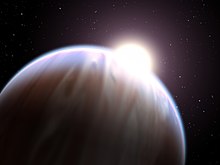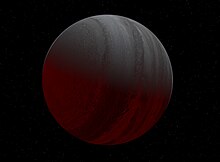| Revision as of 02:22, 7 September 2015 editDN-boards1 (talk | contribs)1,949 edits →Puffy planets: Removed section, due to being split off to its own page.← Previous edit | Revision as of 02:23, 7 September 2015 edit undoDN-boards1 (talk | contribs)1,949 edits →See alsoNext edit → | ||
| Line 70: | Line 70: | ||
| == See also == | == See also == | ||
| * ] | * ] | ||
| * ] | |||
| == References == | == References == | ||
Revision as of 02:23, 7 September 2015


Hot Jupiters (also called roaster planets, epistellar jovians, pegasids or pegasean planets) are a class of extrasolar planets whose characteristics are similar to Jupiter, but that have high surface temperatures because they orbit very close—between approximately 0.015 and 0.5 astronomical units (2.2×10^ and 74.8×10^ km)—to their parent stars, whereas Jupiter orbits its parent star (the Sun) at 5.2 astronomical units (780×10^ km), causing low surface temperatures.
One of the best-known hot Jupiters is 51 Pegasi b, nicknamed Bellerophon. Discovered in 1995, it was the first extrasolar planet found orbiting a Sun-like star. 51 Pegasi b has an orbital period of about 4 days.
General characteristics

Hot Jupiters have some common characteristics:
- They have similar characteristics to Jupiter (gas giants, usually with masses close to or exceeding that of Jupiter, which is 1.9×10 kg); however, they orbit much more closely to the star and experience a high surface temperature.
- They have a much greater chance of transiting their star as seen from a farther outlying point than planets of the same mass in larger orbits. The most notable of these are HD 209458 b, the first transiting hot Jupiter found, HD 189733 b, which was first mapped in 2007 by the Spitzer Space Telescope, and HAT-P-7b, which was recently observed by the Kepler mission.
- Due to high levels of insolation they are of a lower density than they would otherwise be. This has implications for radius determination, because due to limb darkening of the planet's background star during a transit, the planet's ingress and egress boundaries are harder to determine.
- They are all thought to have migrated to their present positions because there would not have been enough material so close to the star for a planet of that mass to have formed in situ.
- Most of these have nearly circular orbits (low eccentricities). This is because their orbits have been circularized, or are being circularized, by tides.
- They exhibit high-speed winds distributing the heat from the day side to the night side, thus the temperature difference between the two sides is relatively low.
- They are more common around F- and G-type stars and somewhat less common around K-type stars. Hot Jupiters around red dwarfs are very rare.
Hot Jupiters are the easiest extrasolar planets to detect via the radial-velocity method, because the oscillations they induce in their parent stars' motion are relatively large and rapid, compared to other known types of planets.
They are thought to form at a distance from the star beyond the frost line, where the planet can form from rock, ice and gases. The planets then migrate inwards to the star where they eventually form a stable orbit. The planets usually move by type 2 migrations, or possibly via interaction with other planets. The migration happens during the solar nebula phase, and will typically stop when the star enters its T-Tauri phase. The strong stellar winds at this time remove most of the remaining nebula.
After their atmospheres and outer layers are stripped away (hydrodynamic escape), their cores may become chthonian planets. The amount of the outermost layers that is lost depends on the size and the material of the planet and the distance from the star. In a typical system a gas giant orbiting 0.02 AU around its parent star loses 5–7% of its mass during its lifetime, but orbiting closer than 0.015 AU can mean evaporation of the whole planet except for its core.
Terrestrial planets in systems with hot Jupiters
Simulations have shown that the migration of a Jupiter-sized planet through the inner protoplanetary disk (the region between 5 and 0.1 AU from the star) is not as destructive as one might assume. More than 60% of the solid disk materials in that region are scattered outward, including planetesimals and protoplanets, allowing the planet-forming disk to reform in the gas giant's wake. In the simulation, planets up to two Earth masses were able to form in the habitable zone after the hot Jupiter passed through and its orbit stabilized at 0.1 AU. Due to the mixing of inner-planetary-system material with outer-planetary-system material from beyond the frost line, simulations indicated that the terrestrial planets that formed after a hot Jupiter's passage would be particularly water-rich.
In 2015, two terrestrial planets were discovered around WASP-47, which has a hot Jupiter.
Retrograde orbit
It has been found that several hot Jupiters have retrograde orbits and this calls into question the theories about the formation of planetary systems, although rather than a planet's orbit having been disturbed, it may be that the star itself flipped over early in their system's formation due to interactions between the star's magnetic field and the planet-forming disc. By combining new observations with the old data it was found that more than half of all the hot Jupiters studied have orbits that are misaligned with the rotation axis of their parent stars, and six exoplanets in this study have retrograde motion.
Ultra-short-period Jupiters
Ultra-short-period Jupiters are a class of hot Jupiters with orbital periods below 1 day and occur only around stars of less than about 1.25 solar masses.
Five ultra-short-period planets have been identified in the region of the Milky Way known as the galactic bulge. They were observed by the Hubble Space Telescope and first described by researchers from the Space Telescope Science Institute, the Universidad Catolica de Chile, Uppsala University, the High Altitude Observatory, the INAF–Osservatorio Astronomico di Padova and the University of California at Los Angeles.
More transiting hot Jupiters have been discovered, such as WASP-18b and WASP-19b, that have orbital periods of less than one day that do not support the hypothesis of the research above.
Moons
Theoretical research suggests that hot Jupiters are unlikely to have moons due to both a small Hill sphere and the tidal forces of the stars they orbit, which would destabilize the satellites' orbits, the latter process being stronger for larger moons. This means that for most hot Jupiters stable satellites would be small, asteroid-sized bodies.
Hot Jupiters around red giants
It has been proposed that, even though no planet of this type has been found until now, gas giants orbiting red giants at distances similar to that of Jupiter could be hot Jupiters due to the intense irradiation they would receive from their stars. It is very likely that in the Solar System Jupiter will become a hot Jupiter when the Sun becomes a red giant.
Hot Jupiters orbiting red giants would differ from those orbiting main-sequence stars in a number of ways, most notably the possibility of accreting material from the stellar winds of their stars and, assuming a fast rotation (not tidally locked to their stars), a much more evenly distributed heat with many narrow-banded jets. Their detection using the transit method would be much more difficult due to their tiny size compared to the stars they orbit, as well as the long time needed (months or even years) for one to transit their star as well as to be occulted by it.
See also
References
- Sharp, A. G.; Moses, J. I.; Friedson, A. J.; Fegley, B.; Marley, M. S.; Lodders, K. (2004), "Predicting the Atmospheric Composition of Extrasolar Giant Planets" (PDF), 35th Lunar and Planetary Science Conference, 35, Lunar and Planetary Science Conference: 1152, Bibcode:2004LPI....35.1152S
- Darling, David, epistellar jovians, The Internet Encyclopedia of Science
- Odenwald, Sten, What is an "Epistellar Jovian Exoplanet"?, The Astronomy Cafe
- Interiors of extrasolar planets: A first step (PDF), Astronomy & Astrophysics, 2006-05-30
- Than, Ker (2006-06-05), Inside Exoplanets: Motley Crew of Worlds Share Common Thread, Space.com
- ^ Flipping Hot Jupiters : Northwestern University Newscenter
- Mathiesen, Ben (2006-03-19), 'Hot Jupiter' Systems may Harbor Earth-like Planets, PhysOrg.com
- Fabrycky, D. and Tremaine, S. (2007-11-10). "Shrinking Binary and Planetary Orbits by Kozai Cycles with Tidal Friction". ApJ. 669: 1298–1315. doi:10.1086/521702.
{{cite journal}}: CS1 maint: multiple names: authors list (link) - Characterizing the Cool KOIs II. The M Dwarf KOI-254 and its Hot Jupiter: John Asher Johnson, J. Zachary Gazak, Kevin Apps, Philip S. Muirhead, Justin R. Crepp, Ian J. M. Crossfield, Tabetha Boyajian, Kaspar von Braun, Barbara Rojas-Ayala, Andrew W. Howard, Kevin R. Covey, Everett Schlawin, Katherine Hamren, Timothy D. Morton, James P. Lloyd
- Chambers, John (2007-07-01). Planet Formation with Type I and Type II Migration. AAS/Division of Dynamical Astronomy Meeting. Vol. 38. Bibcode:2007DDA....38.0604C.
- "Exoplanets Exposed to the Core". 2009-04-25. Retrieved 2009-04-25.
- ^ Fogg, Martyn J.; Nelson, Richard P. (2007), "On the formation of terrestrial planets in hot-Jupiter systems", A&A, 461 (3): 1195–1208, arXiv:astro-ph/0610314, Bibcode:2007A&A...461.1195F, doi:10.1051/0004-6361:20066171.
- http://arxiv.org/abs/1508.02411
- "Turning planetary theory upside down", ESO Press Release, Royal Astronomical Society: 16, 2010-04-13, Bibcode:2010eso..pres...16
{{citation}}: Check|bibcode=length (help) - Tilting stars may explain backwards planets, New Scientist, 01 September 2010, Magazine issue 2776.
- ^ Sahu, K.C. et al. 2006. Transiting extrasolar planetary candidates in the Galactic bulge. Nature 443:534-540
- "Stability of Satellites around Close-in Extrasolar Giant Planets
- ^ Jupiter will Become a Hot Jupiter: Consequences of Post-main-sequence Stellar Evolution on Gas Giant Planets
External links
- Inside Exoplanets: Motley Crew of Worlds Share Common Thread
- NASA: Global temperature map of an exoplanet
- First known theoretical prediction about existence of Hot Jupiters - by Otto Struve in 1952.
- Audio: Cain/Gay Hot Jupiters and Pulsar Planets - Sept 2006.
